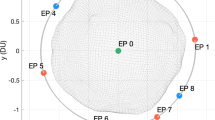Abstract
I have computed proper elements for 174 asteroids in the 1 : 1 resonance with Jupiter, that is for all the reliable orbits available (numbered and multi-opposition). The procedure requires numerical integration, under the perturbations by the four major planets, for 1,000,000 years; the output is digitally filtered and compressed into a “synthetic theory” (as defined within theLONGSTOP project). The proper modes of oscillation of the variables related to eccentricity, perihelion, inclination and node define proper elements. A third proper element is defined as the amplitude of the oscillation of the semimajor axis associated with the libration period; because of the strong nonlinearity of the problem, this component cannot be determined by a simple Fourier transform to the frequency domain. I therefore give another definition, which results in very good stability with time. For 87% of the computed orbits, the stability of the proper elements-at least over 1M yr-is within the following bounds: 0.001AU in semimajor axis, 0.0025 in eccentricity and sine of inclination. Half of the cases with degraded stability of the proper elements are found to be chaotic, with e-folding times between 16,000 and 660,000yr; in some other cases, chaotic behaviour does not result in a significantly decreased stability of the proper elements (stable chaos). The accuracy and stability of these proper elements is good enough to allow a search for asteroid families; however, the dynamical structure of the Trojan belt is very different from the one of the main belt, and collisional events among Trojans can result in a distribution of fragments difficult to identify. The occurrence of couples of Trojans with very close proper elements is proven not to be statistically significant in almost all cases. As the only exception, the couple 1583 Antilochus — 3801 Thrasimedes is significant; however, it is not easy to account for it by a conventional collisional theory. The Menelaus group is confirmed as a strong candidate collisional family; Teucer and Sarpedon could be considered as significant clusters. A number of other clumps are detected (by the same automated clustering method used for the main belt by Zappalà et al., 1990, 1992), but the total number of Trojans with reliable orbits is not large enough to detect many significant candidate families.
Similar content being viewed by others
References
Bien, R. and Schubart, J.: 1986, “Two Trojans near a secular resonance: (1173) Anchises and (1871) Astyanax, inAsteroids Comets Meteors II, Lagerkvist C.-I. and Rickmann, H. eds., Uppsala University, pp. 157–160.
Bien, R. and Schubart, J.: 1987, “Three characteristic parameters for the Trojan group of asteroids”,Astron. Astrophys. 175, 292–298.
Carpino, M., Milani, A. and Nobili, A.M.: 1987. “Long-term numerical integrations and synthetic theories for the motion of the outer planets”,Astron. Astrophys. 181, 182–194.
Érdi, B.: 1988, “Long periodic perturbations of Trojan asteroids”,Celest. Mech. 43, 303–308.
Farinella, P. and Davis, D.: 1992, “Collision rates and impact velocities in the main asteroid belt”,Icarus, in press.
Ferraz-Mello, S.: 1981, “Estimation of periods from unequally spaced observations”,Astron. J. 86, 619–624.
Milani, A., and Knežević, Z.: 1990, “Secular perturbation theory and computation of asteroid proper elements”.Celestial Mechanics 49, 247–411.
Milani, A., and Knežević, Z.: 1992, “Asteroid proper elements and secular resonances.”Icarus 98, 211–232.
Milani, A. and Nobili, A.M.: 1988, “Integration error over a very long time span”Celestial Mechanics 43, 1–34.
Milani, A. and Nobili, A.M.: 1992, “An example of stable chaos in the Solar System”Nature 357, 569–571.
Milani, A., Farinella, P. and Knežević, Z.: 1992, “On the search for asteroid families”, inPhysics and Dynamics of Minor Bodies of the Solar System, Benest, D. and Froeschlé, C. eds., Editions Frontière, in press.
Morbidelli, A.: 1991, “Perturbation methods and asteroid dynamics”, Ph.D. thesis, Univ. Namur, Belgium.
Nakai, H. and Kinoshita, H.: 1985, “Secular perturbations of asteroids in secular resonance”,Celestial Mechanics 36, 391–407.
Nobili, A.M., Milani, A. and Carpino, M.: 1989, “Fundamental frequencies and small divisors in the orbits of the outer planets”Astron. Astrophys. 210, 313–336.
Schoemaker, E. M., Schoemaker, C. S. and Wolfe, R.F.: 1992, “Systematic survey for bright Jupiter Trojans”, inProceedings of ACM 91, Bowell, E. ed., Lunar and Planetary Institute, in press.
Schoemaker, E. M., Schoemaker, C. S. and Wolfe, R.F.: 1989, “Trojan asteroids: population, dynamical structure and origin of the L4 and L5 swarms”, inAsteroids II, Binzel. R. and Mattews, M. eds., Arizona University press, pp. 487–523.
Schubart, J. and Bien, R.: 1984, “An application of Labrouste's method to quasi-periodic asteroidal motion”,Celestial Mechanics 34, 443–452.
Schubart, J. and Bien, R.: 1987, “Trojan asteroids: relations between dynamical parameters”,Astron. Astrophys. 175, 299–302.
Van Houten, C.J., Van Houten-Groeneveld, I., Wisse-Schouten, M., Bardwell, C., Green, D.W.E., and Gehrels, T.: 1991, ‘The second Palomar-Leiden Trojan survey”,Icarus 91, 326–333.
Williams, J.G.: 1969, “Secular perturbations in the Solar System” Ph.D. Thesis, Univ. California Los Angeles.
Zappalà, V., Cellino, A., Farinella, P. and Knežević, Z.: 1990, “Asteroid families I: identification by hierarchical clustering and reliability assessment”,Astron. J. 100, 2030–2046.
Zappalà, V., Cellino, A., Farinella, P. and Milani, A.: 1992, “Asteroid families II: extension to unumbered multi opposition asteroids”, preprint.




